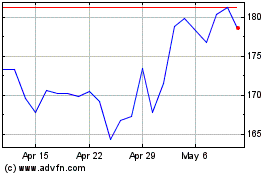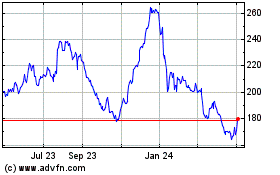By Andy Pasztor
U.S. air-safety regulators are set to begin key flight tests of
Boeing Co.'s 737 MAX as early as Monday, amid growing expectations
by industry and government officials that the planes are likely to
return to service around the end of the year.
The airborne checks, slated to be conducted in conjunction with
Boeing and scheduled to last three days, mark a preliminary
validation and long-awaited milestone for Boeing's technical fixes
aimed at getting the MAX fleet back in the air. The planes have
been grounded for 15 months following two accidents that killed 346
people, roiled the airline industry long before the coronavirus
pandemic and dealt the biggest blow to the plane maker's reputation
in its 103-year history.
In an email the Federal Aviation Administration sent to
congressional staffers Sunday, the agency said the effort "will
include an array of flight maneuvers and emergency procedures to
enable the agency to assess" whether a series of software and
hardware changes complies with safety certification standards.
But as expected, the FAA stressed agency officials haven't even
tentatively completed those evaluations yet, while the message laid
out a handful of additional steps anticipated to take at least
several months -- some involving outside experts, foreign
authorities and requests for public comment.
Still, after more than a year of delays, persistent new
engineering challenges and friction between senior FAA officials
and Boeing's management, Sunday's message laid out the clearest
path yet for resurrecting the MAX.
The crashes, which occurred less than five months apart in late
2018 and early 2019, kicked off debates in Congress and throughout
the industry about FAA procedures and safeguards for approving the
safety of new jetliner designs. The deaths also touched off a
federal criminal investigation and prompted substantial changes in
decades-old assumptions about how typical pilots interact with
complex cockpit automation.
A Boeing spokesman said: "We continue to work diligently on
safely returning the MAX to service."
FAA officials have consistently said they wouldn't move toward
authorizing such test flights or taking other actions to recertify
the MAX until all the agency's questions and concerns were answered
satisfactorily. Leading up to test flights, Boeing has conducted
more than 2,000 hours of flights to validate new software.
The world-wide slump in passengers resulting from the Covid-19
pandemic, though, has sharply reduced the airline industry's
appetite for flying the troubled planes, and Boeing has
dramatically scaled back its own production rates from previous
levels.
Before making the decision Friday to schedule test pilots to vet
various software fixes and changes to the jet's flight-control
systems, the FAA formally signed off on a series of Boeing
technical analyses and risk assessments that had taken months.
Within days of the second crash, Boeing launched an effort to
develop initial software revisions to an automated flight-control
system called MCAS, which misfired, overpowered pilot commands and
put both MAX jets into nosedives.
Under prodding from the FAA and international regulators, Boeing
since then has revised several other features of the MAX's
flight-control computers and associated hardware, including
agreeing to relocate certain electrical wiring under the cabin to
avoid hazardous short circuits.
The test flights, once planned for the summer of 2019, continued
to be postponed as FAA and Boeing experts expanded their work to
cover an array of new safety issues and previously unexamined
computer shortcomings.
Even if the flight tests go well, the MAX faces more testing of
the plane's handling by a group of international pilots, further
analyses by pilot-training officials, verification by teams of
outside safety experts and extensive maintenance work before the
jetliners can be deemed ready to fly passengers.
In addition, Canadian and European regulators are pushing for
other software changes that could be phased in over a year or more,
once the planes return to service. Such separate safety tracts,
according to many industry officials, threaten to erode the FAA's
historic stature as the world's dominant air-safety regulator.
"There likely will be multiple changes attempted, many for
nontechnical issues which will consume lots of time," said Ray
Valeika, retired head of maintenance and engineering at Delta Air
Lines Inc.
Over the months leading up to the decision to schedule the
flights, industry and government officials projected that the FAA
was likely to officially lift its order grounding the planes by
early fall.
Airline officials have said they anticipate needing roughly two
months after such a move to prepare aircraft for flight, phase them
into their fleets and arrange for pilots to complete extra training
in ground-based flight simulators expected to be required by the
FAA. With some potentially important exceptions, international
regulators are expected to follow the FAA's lead and clear the
planes to fly within weeks of a final U.S. announcement.
Some 800 MAX planes are grounded, with roughly half of them in
storage under Boeing's control because they were never delivered to
customers.
With thousands of jetliners of various types sitting idle around
the world because of the coronavirus pandemic, industry officials
expect most airlines to move slowly to fit 737 MAX planes into
truncated schedules.
Results of the test flights aren't likely to be released
immediately, and a formal write-up could take weeks, according to
industry and government officials. Later this summer, House and
Senate leaders are expected to engage on provisions in rival bills
intended to overhaul FAA certification of new aircraft designs.
FAA chief Steve Dickson, a former military and airline pilot,
has said that before the agency's decision, he would personally
test the revised software.
To boost passenger confidence in the redone flight controls,
U.S. airline officials previously raised the possibility of
conducting their own demonstration flights of MAX aircraft with
executives and pilot-union leaders on board. The FAA has also
considered strategies to explain the changes to regulators in other
countries to ensure a coordinated return of the fleet.
Earlier this month, Boeing sent airline customers draft training
materials, including more than a handful of revised checklists and
rewritten emergency procedures, to pave the way for returning the
MAX to service. At the time, the plane maker said it had worked
closely with aviation authorities on the draft, noting that
multiple regulators requested different changes to cockpit
procedures.
Andrew Tangel contributed to this article.
Write to Andy Pasztor at andy.pasztor@wsj.com
(END) Dow Jones Newswires
June 28, 2020 17:56 ET (21:56 GMT)
Copyright (c) 2020 Dow Jones & Company, Inc.
Boeing (NYSE:BA)
Historical Stock Chart
From Jun 2024 to Jul 2024

Boeing (NYSE:BA)
Historical Stock Chart
From Jul 2023 to Jul 2024
